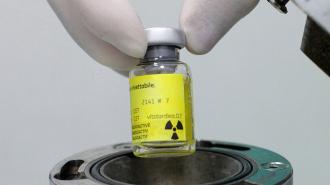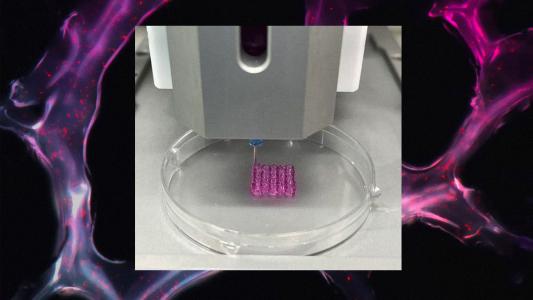This article is an installment of Future Explored, a weekly guide to world-changing technology. You can get stories like this one straight to your inbox every Thursday morning by subscribing here.
Drugs that emit radiation to kill cancer are making their way out of the lab and into patients — but to really transform how we fight this disease, they’ll need to overcome challenges with manufacturing and distribution.
Radiopharmaceuticals
Cancer treatment often starts with surgery to remove as much of the cancer from the body as possible. Patients might then undergo chemotherapy, radiation, or both to kill any cancer cells left behind during the operation.
While chemo uses drugs to kill cancer cells, radiation therapy uses targeted beams of high-energy radiation, often x-rays. The radiation damages the DNA of cancer cells, slowing their growth or killing them outright.
Radiation therapy is usually administered by having a patient stay very still while a large machine aims the beam of radiation at the site of their cancer. However, on the way to the cancer, the radiation may damage healthy cells, potentially causing side effects such as fatigue, hair loss, and damage to the skin.
“Radiopharmaceuticals are very useful for disease that is widespread or disease that we cannot completely image.”
Sean Cavanaugh
Radiopharmaceuticals are an alternative to traditional radiation therapy.
These drugs typically consist of three parts: a radioactive isotope, a targeting molecule that sticks to cancer cells, and some “linker” to connect the two. Once in a patient’s bloodstream, the targeting molecule binds to a cancer cell; as the radioactive isotope decays, it releases energy that can destroy the DNA of nearby cells, killing the cancer while damaging fewer healthy cells than traditional external radiation therapy.
“Some radiopharmaceuticals are chemically targeted so they are attracted to something like damaged bone, or a certain target chemical, or they are an isotope only certain cells would want to take in,” radiation oncologist Sean Cavanaugh told City of Hope in 2021.
“Because of this, they are very useful for disease that is widespread or disease that we cannot completely image,” continued Cavanaugh.
The latest candidate
Since 2002, the FDA has approved a handful of radiopharmaceuticals to treat cancer, including pharma giant Novartis’s Pluvicto, which extended overall survival by a median of four months (from 11.3 months to 15.3 months) in trials of people with certain types of metastatic prostate cancer.
About a third of trial participants didn’t respond to Pluvicto, though, and researchers in Switzerland think it’s because the dose of radiation the drug delivers to the smallest tumor cells isn’t enough to kill them, and after they escape, those cells multiply.
An approved radiopharmaceutical for pancreatic cancer extends overall survival time by a median of 35%.
These Swiss researchers — who hail from the Paul Scherrer Institute (PSI), the University Hospital Basel, and ETH Zurich — believe the isotope terbium-161 is the key to creating a more effective radiopharmaceutical to treat prostate cancer.
Compared to the isotope used in Pluvicto (lutetium-177), terbium-161 emits radiation across a wider range of energies, including ones that travel shorter distances. In a radiopharmaceutical context, this would mean more radiation precisely where it’s needed.
Lab and animal studies have already proven the researchers’ theory that terbium-161 can outperform lutetium-177, and the group has now secured $2.3 million to further research their radiopharmaceutical with the PROGNOSTICS project.
The project will include a clinical trial at the University Hospital Basel in which 30 people with metastatic prostate cancer will be treated with a terbium-161 drug. That trial is expected to start in 2024 and wrap up by the end of 2025.
The cold water
If the Swiss team’s radiopharmaceutical performs well in this small trial, larger ones could follow, eventually leading to a more effective treatment for prostate cancer, which kills about 375,000 people every year.
Even if the medication is approved, though, patients might have a hard time accessing it due to challenges inherent in manufacturing and distributing radiopharmaceuticals.
The radioactive isotopes used in radiopharmaceuticals are created inside nuclear research reactors or in particle accelerators, which require special licenses and training to operate. The drugs then need to be administered within days of manufacturing, because the isotopes decay so quickly.
“With a traditional pharmaceutical, you’re trained to use every vial produced,” said Luke Augustine, a VP of business development for radiopharmaceutical manufacturer Cardinal Health. “With a radiopharmaceutical, you’re dealing with a ‘melting ice cube.’ You have to be prepared to manufacture daily, not periodically.”
“We have patients on months-long waiting lists when this may be all the time they have.”
Roby Thomas
In February 2023, oncologists across the US reported having to delay their patients’ treatments of Pluvicto due to supply constraints, and the situation developed to the point that Novartis temporarily stopped accepting new patient orders.
“We have patients on months-long waiting lists when this may be all the time they have, and so it’s been really disheartening to have to deal with these things,” Roby Thomas, a medical oncologist, told Targeted Therapies in Oncology.
“The number of nuclear medicine physicians in the US is small.”
Frank Lin
At the time Novartis issued its halt on new patients, just one facility in Italy was manufacturing the entire US supply of Pluvicto. In April, the company received FDA approval to begin making it at a plant in New Jersey, too, and it subsequently began accepting new orders again.
Manufacturing is just one challenge with radiopharmaceuticals, though — relatively few doctors have undergone the special training and licensing required to administer the drugs.
“The number of nuclear medicine physicians in the US is small,” said Frank Lin, an oncologist at the National Cancer Institute’s (NCI) Center for Cancer Research. “And I think we only train maybe 70 or 80 new people a year.”
“I think they’re going to transform radiation oncology in the next 10 to 15 years.”
Charles Kunos
The bottom line
Radiopharmaceuticals are a growing field of cancer research, with several new candidates entering clinical trials.
If manufacturers can keep the supply chain stable, and more healthcare workers receive the training needed to administer the drugs, radiopharmaceuticals could join surgery, chemo, and traditional radiation therapy as one of the most valuable weapons in our cancer-fighting arsenal.
“I think they’re going to transform radiation oncology in the next 10 to 15 years,” said Charles Kunos, a radiation oncologist at the NCI.
We’d love to hear from you! If you have a comment about this article or if you have a tip for a future Freethink story, please email us at [email protected].






